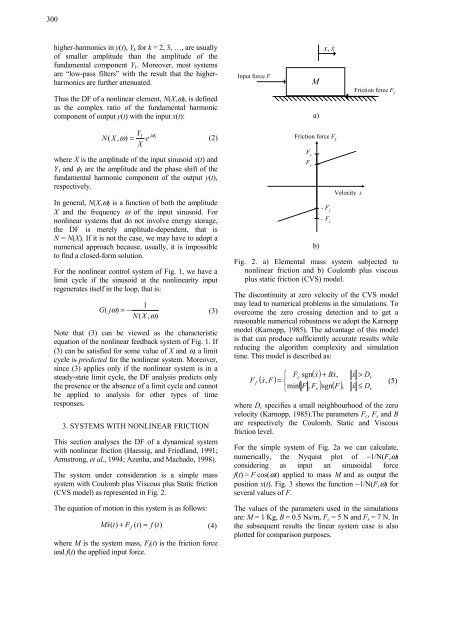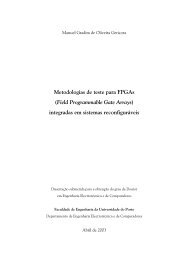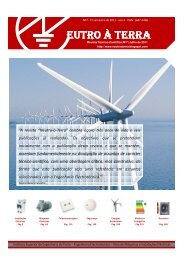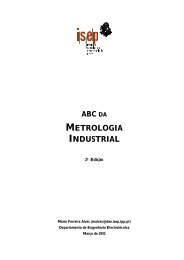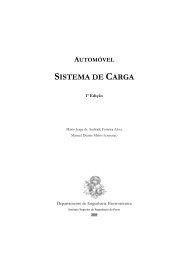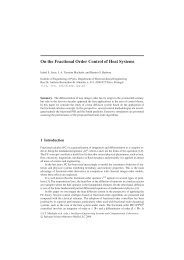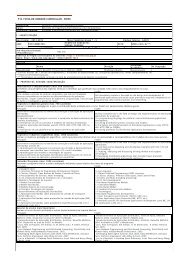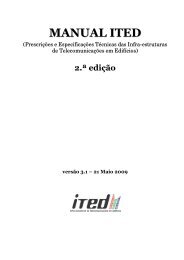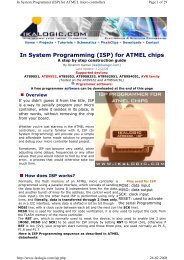describing function analysis of mechanical systems with nonlinear ...
describing function analysis of mechanical systems with nonlinear ...
describing function analysis of mechanical systems with nonlinear ...
Create successful ePaper yourself
Turn your PDF publications into a flip-book with our unique Google optimized e-Paper software.
higher-harmonics in y(t), Y k for k = 2, 3, …, are usually<br />
<strong>of</strong> smaller amplitude than the amplitude <strong>of</strong> the<br />
fundamental component Y 1 . Moreover, most <strong>systems</strong><br />
are “low-pass filters” <strong>with</strong> the result that the higherharmonics<br />
are further attenuated.<br />
Input force F<br />
M<br />
x , x&<br />
Thus the DF <strong>of</strong> a <strong>nonlinear</strong> element, N(X,ω), is defined<br />
as the complex ratio <strong>of</strong> the fundamental harmonic<br />
component <strong>of</strong> output y(t) <strong>with</strong> the input x(t):<br />
a)<br />
Friction force F f<br />
1<br />
N X = (2)<br />
(<br />
, ω)<br />
Y1<br />
e<br />
X<br />
where X is the amplitude <strong>of</strong> the input sinusoid x(t) and<br />
Y 1 and φ 1 are the amplitude and the phase shift <strong>of</strong> the<br />
fundamental harmonic component <strong>of</strong> the output y(t),<br />
respectively.<br />
In general, N(X,ω) is a <strong>function</strong> <strong>of</strong> both the amplitude<br />
X and the frequency ω <strong>of</strong> the input sinusoid. For<br />
<strong>nonlinear</strong> <strong>systems</strong> that do not involve energy storage,<br />
the DF is merely amplitude-dependent, that is<br />
N = N(X). If it is not the case, we may have to adopt a<br />
numerical approach because, usually, it is impossible<br />
to find a closed-form solution.<br />
For the <strong>nonlinear</strong> control system <strong>of</strong> Fig. 1, we have a<br />
limit cycle if the sinusoid at the <strong>nonlinear</strong>ity input<br />
regenerates itself in the loop, that is:<br />
jφ<br />
1<br />
G(<br />
jω)<br />
= −<br />
(3)<br />
N(<br />
X , ω)<br />
Note that (3) can be viewed as the characteristic<br />
equation <strong>of</strong> the <strong>nonlinear</strong> feedback system <strong>of</strong> Fig. 1. If<br />
(3) can be satisfied for some value <strong>of</strong> X and ω, a limit<br />
cycle is predicted for the <strong>nonlinear</strong> system. Moreover,<br />
since (3) applies only if the <strong>nonlinear</strong> system is in a<br />
steady-state limit cycle, the DF <strong>analysis</strong> predicts only<br />
the presence or the absence <strong>of</strong> a limit cycle and cannot<br />
be applied to <strong>analysis</strong> for other types <strong>of</strong> time<br />
responses.<br />
3. SYSTEMS WITH NONLINEAR FRICTION<br />
This section analyses the DF <strong>of</strong> a dynamical system<br />
<strong>with</strong> <strong>nonlinear</strong> friction (Haessig, and Friedland, 1991;<br />
Armstrong, et al., 1994; Azenha, and Machado, 1998).<br />
The system under consideration is a simple mass<br />
system <strong>with</strong> Coulomb plus Viscous plus Static friction<br />
(CVS model) as represented in Fig. 2.<br />
The equation <strong>of</strong> motion in this system is as follows:<br />
M& x<br />
( t)<br />
+ Ff ( t)<br />
= f ( t)<br />
(4)<br />
where M is the system mass, F f (t) is the friction force<br />
and f(t) the applied input force.<br />
Friction force F f<br />
F s<br />
F c<br />
b)<br />
- F c<br />
Velocity x&<br />
- F s<br />
Fig. 2. a) Elemental mass system subjected to<br />
<strong>nonlinear</strong> friction and b) Coulomb plus viscous<br />
plus static friction (CVS) model.<br />
The discontinuity at zero velocity <strong>of</strong> the CVS model<br />
may lead to numerical problems in the simulations. To<br />
overcome the zero crossing detection and to get a<br />
reasonable numerical robustness we adopt the Karnopp<br />
model (Karnopp, 1985). The advantage <strong>of</strong> this model<br />
is that can produce sufficiently accurate results while<br />
reducing the algorithm complexity and simulation<br />
time. This model is described as:<br />
F<br />
f<br />
( x&<br />
F)<br />
( x&<br />
)<br />
⎧ Fc<br />
sgn + Bx&<br />
, x&<br />
> Dv<br />
, = ⎨<br />
(5)<br />
⎩min( F , Fs<br />
) sgn( F)<br />
, x&<br />
≤ Dv<br />
where D v specifies a small neighbourhood <strong>of</strong> the zero<br />
velocity (Karnopp, 1985).The parameters F c , F s and B<br />
are respectively the Coulomb, Static and Viscous<br />
friction level.<br />
For the simple system <strong>of</strong> Fig. 2a we can calculate,<br />
numerically, the Nyquist plot <strong>of</strong> −1/N(F,ω)<br />
considering as input an sinusoidal force<br />
f(t) = F cos(ωt) applied to mass M and as output the<br />
position x(t). Fig. 3 shows the <strong>function</strong> −1/N(F,ω) for<br />
several values <strong>of</strong> F.<br />
The values <strong>of</strong> the parameters used in the simulations<br />
are: M = 1 Kg, B = 0.5 Ns/m, F c = 5 N and F s = 7 N. In<br />
the subsequent results the linear system case is also<br />
plotted for comparison purposes.


